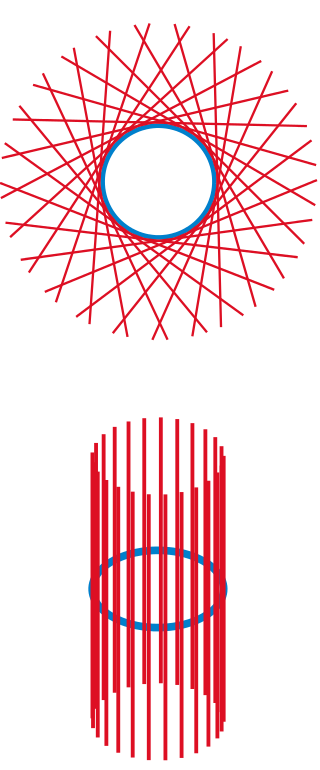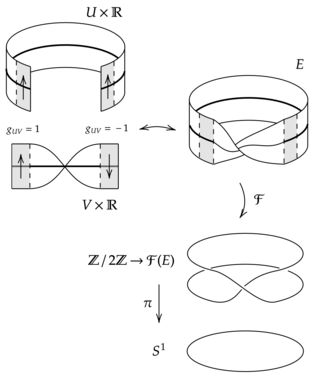In mathematics, a double vector bundle is the combination of two compatible vector bundle structures, which contains in particular the tangent of a vector bundle and the double tangent bundle .
In mathematics, a double vector bundle is the combination of two compatible vector bundle structures, which contains in particular the tangent of a vector bundle and the double tangent bundle .
A double vector bundle consists of , where
A double vector bundle morphism consists of maps , , and such that is a bundle morphism from to , is a bundle morphism from to , is a bundle morphism from to and is a bundle morphism from to .
The 'flip of the double vector bundle is the double vector bundle .
If is a vector bundle over a differentiable manifold then is a double vector bundle when considering its secondary vector bundle structure.
If is a differentiable manifold, then its double tangent bundle is a double vector bundle.
In mathematics, specifically category theory, a functor is a mapping between categories. Functors were first considered in algebraic topology, where algebraic objects are associated to topological spaces, and maps between these algebraic objects are associated to continuous maps between spaces. Nowadays, functors are used throughout modern mathematics to relate various categories. Thus, functors are important in all areas within mathematics to which category theory is applied.

In geometry, a geodesic is a curve representing in some sense the shortest path (arc) between two points in a surface, or more generally in a Riemannian manifold. The term also has meaning in any differentiable manifold with a connection. It is a generalization of the notion of a "straight line".

A tangent bundle is the collection of all of the tangent spaces for all points on a manifold, structured in a way that it forms a new manifold itself. Formally, in differential geometry, the tangent bundle of a differentiable manifold is a manifold which assembles all the tangent vectors in . As a set, it is given by the disjoint union of the tangent spaces of . That is,
In mathematics and physics, a tensor field assigns a tensor to each point of a mathematical space. Tensor fields are used in differential geometry, algebraic geometry, general relativity, in the analysis of stress and strain in materials, and in numerous applications in the physical sciences. As a tensor is a generalization of a scalar and a vector, a tensor field is a generalization of a scalar field or vector field that assigns, respectively, a scalar or vector to each point of space. If a tensor A is defined on a vector fields set X(M) over a module M, we call A a tensor field on M.

In mathematics, a vector bundle is a topological construction that makes precise the idea of a family of vector spaces parameterized by another space : to every point of the space we associate a vector space in such a way that these vector spaces fit together to form another space of the same kind as , which is then called a vector bundle over .

In mathematics, and particularly topology, a fiber bundle is a space that is locally a product space, but globally may have a different topological structure. Specifically, the similarity between a space and a product space is defined using a continuous surjective map, that in small regions of behaves just like a projection from corresponding regions of to The map called the projection or submersion of the bundle, is regarded as part of the structure of the bundle. The space is known as the total space of the fiber bundle, as the base space, and the fiber.
In mathematics, a Lie algebroid is a vector bundle together with a Lie bracket on its space of sections and a vector bundle morphism , satisfying a Leibniz rule. A Lie algebroid can thus be thought of as a "many-object generalisation" of a Lie algebra.
In mathematics, a Lie groupoid is a groupoid where the set of objects and the set of morphisms are both manifolds, all the category operations are smooth, and the source and target operations

In mathematics, a frame bundle is a principal fiber bundle F(E) associated to any vector bundle E. The fiber of F(E) over a point x is the set of all ordered bases, or frames, for Ex. The general linear group acts naturally on F(E) via a change of basis, giving the frame bundle the structure of a principal GL(k, R)-bundle (where k is the rank of E).
In mathematics, particularly differential geometry, a Finsler manifold is a differentiable manifold M where a (possibly asymmetric) Minkowski normF(x, −) is provided on each tangent space TxM, that enables one to define the length of any smooth curve γ : [a, b] → M as
This is a glossary of terms specific to differential geometry and differential topology. The following three glossaries are closely related:

In differential geometry, an affine connection is a geometric object on a smooth manifold which connects nearby tangent spaces, so it permits tangent vector fields to be differentiated as if they were functions on the manifold with values in a fixed vector space. Connections are among the simplest methods of defining differentiation of the sections of vector bundles.
In differential geometry, a field in mathematics, a Poisson manifold is a smooth manifold endowed with a Poisson structure. The notion of Poisson manifold generalises that of symplectic manifold, which in turn generalises the phase space from Hamiltonian mechanics.
In differential geometry, a G-structure on an n-manifold M, for a given structure group G, is a principal G-subbundle of the tangent frame bundle FM (or GL(M)) of M.

In mathematics, a differentiable manifold is a type of manifold that is locally similar enough to a vector space to allow one to apply calculus. Any manifold can be described by a collection of charts (atlas). One may then apply ideas from calculus while working within the individual charts, since each chart lies within a vector space to which the usual rules of calculus apply. If the charts are suitably compatible, then computations done in one chart are valid in any other differentiable chart.
In mathematics, a Banach bundle is a vector bundle each of whose fibres is a Banach space, i.e. a complete normed vector space, possibly of infinite dimension.
In differential geometry, an Ehresmann connection is a version of the notion of a connection, which makes sense on any smooth fiber bundle. In particular, it does not rely on the possible vector bundle structure of the underlying fiber bundle, but nevertheless, linear connections may be viewed as a special case. Another important special case of Ehresmann connections are principal connections on principal bundles, which are required to be equivariant in the principal Lie group action.
In mathematics, a microbundle is a generalization of the concept of vector bundle, introduced by the American mathematician John Milnor in 1964. It allows the creation of bundle-like objects in situations where they would not ordinarily be thought to exist. For example, the tangent bundle is defined for a smooth manifold but not a topological manifold; use of microbundles allows the definition of a topological tangent bundle.
In mathematics, particularly differential topology, the double tangent bundle or the second tangent bundle refers to the tangent bundle (TTM,πTTM,TM) of the total space TM of the tangent bundle (TM,πTM,M) of a smooth manifold M . A note on notation: in this article, we denote projection maps by their domains, e.g., πTTM : TTM → TM. Some authors index these maps by their ranges instead, so for them, that map would be written πTM.
In mathematics, particularly differential topology, the secondary vector bundle structure refers to the natural vector bundle structure (TE, p∗, TM) on the total space TE of the tangent bundle of a smooth vector bundle (E, p, M), induced by the push-forward p∗ : TE → TM of the original projection map p : E → M. This gives rise to a double vector bundle structure (TE,E,TM,M).
Mackenzie, K. (1992), "Double Lie algebroids and second-order geometry, I", Advances in Mathematics , 94 (2): 180–239, doi: 10.1016/0001-8708(92)90036-k